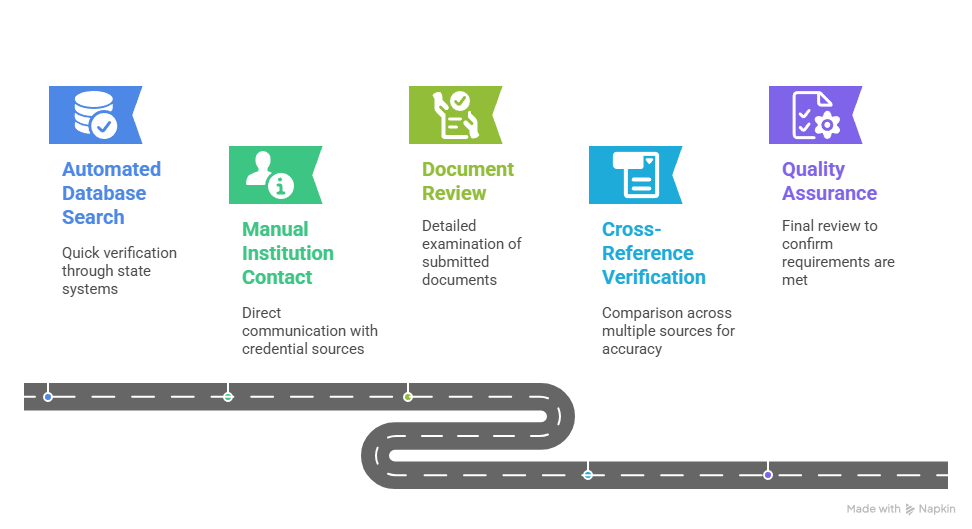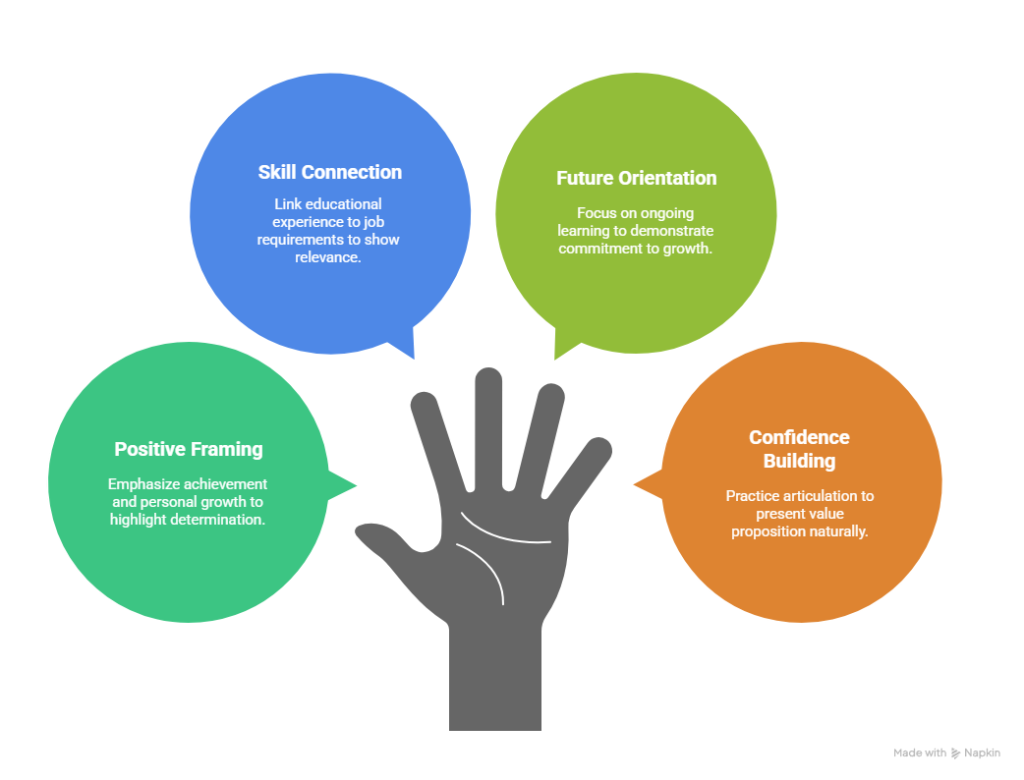When employers run a GED background check, your educational credentials appear identically to traditional high school diploma verification, with no indication of the path you took to earn your secondary education certification. Both GED certificates and high school diplomas fulfill the same legal requirement for "high school education or equivalent" that most employers seek during their hiring process.
Key Takeaways
- GED certificates and high school diplomas appear virtually identical on employment background checks, with both showing completion of secondary education requirements.
- Employers cannot legally discriminate between GED holders and traditional high school graduates under most federal and state employment laws.
- Educational verification processes focus on confirming credential authenticity rather than distinguishing between different types of secondary education completion.
- Most job applications and background check forms use inclusive language like "high school diploma or equivalent" to encompass all valid secondary education credentials.
- GED test scores and specific testing details typically don't appear on standard employment background screenings unless specifically requested by specialized employers.
- Professional industries increasingly value skills and experience over the specific method of obtaining secondary education credentials.
How Educational Background Checks Actually Work
Educational verification represents a standard part of comprehensive employment screening processes across all industries. Most employers partner with established third-party screening companies to confirm candidates' stated educational achievements accurately, while these sophisticated background check systems access multiple databases maintained by educational institutions, state departments of education, and testing services nationwide. When conducting a GED background check, employers typically receive streamlined confirmation of secondary education completion without specific details about testing methods, preparation timelines, or individual performance metrics. The verification process focuses primarily on authenticity and fraud prevention rather than educational pathway analysis, and modern applicant tracking systems treat GED certificates and traditional diplomas as equivalent credentials that meet identical employment requirements. Cloud-based verification systems now provide real-time access to credential databases, which has reduced verification timeframes from weeks to hours in most cases while benefiting all job seekers including GED holders who previously faced longer verification delays.
Legal Protections for GED Holders in Employment
Federal employment law provides comprehensive protections against educational discrimination for GED certificate holders through multiple regulatory frameworks. The Equal Employment Opportunity Commission (EEOC) guidelines explicitly prohibit employers from treating GED credentials differently than traditional high school diplomas unless specific job requirements justify such distinctions. These protections ensure equitable employment opportunities regardless of educational pathway choices or personal circumstances.

- Federal EEOC Guidelines: Prevent educational pathway discrimination for employers with 15+ employees. These guidelines apply to hiring, promotion, and termination decisions across all covered employers. Violations can result in significant penalties and legal action against discriminating companies.
- State Employment Laws: Reinforce credential equivalency standards in most states with additional protections. State laws often provide stronger protections than federal minimums and may cover smaller employers. Many states explicitly recognize GED certificates as legally equivalent to high school diplomas in their employment statutes.
- Civil Rights Protections: Address intersectional discrimination with universal coverage for all workers. These protections become particularly important when educational discrimination combines with other protected characteristics. Courts consistently rule that disparate impact discrimination applies to educational pathway preferences.
- Americans with Disabilities Act: Provide additional protections for individuals whose disabilities affected traditional education. The ADA recognizes that some people pursue alternative education due to disability-related circumstances. These protections ensure that educational pathway choices don't become barriers to employment opportunities.
Most state laws reinforce federal protections while legal precedents consistently support equal treatment of secondary education credentials in hiring decisions. Professional licensing boards and government agencies increasingly adopt inclusive language recognizing educational equivalency in their qualification standards.
What Information Appears on Employment Screenings
Standard employment background checks display educational credentials in carefully formatted presentations that emphasize completion rather than methodology. Screening reports typically show neutral language such as "High School Education Completed" or "Secondary Education Verified" that deliberately avoids distinguishing between GED certificates and traditional diplomas. This standardized presentation helps eliminate unconscious bias in hiring decisions while providing necessary verification information.
| Information Type | What Employers See |
| Credential Type | High school diploma or equivalent certification |
| Completion Date | Month and year of educational achievement |
| Issuing Authority | School district, state education department, or testing service |
| Verification Status | Confirmed authentic, pending review, or unable to verify |
Background check companies design their reporting systems to comply with equal opportunity employment guidelines. These systems focus on meeting stated job requirements rather than highlighting credential differences that could influence hiring decisions inappropriately.
Industry Standards and Employer Attitudes
Modern employment practices increasingly emphasize skills-based hiring methodologies over traditional educational pathway preferences, reflecting evolving workforce dynamics and talent acquisition strategies. Major corporations including Google, IBM, Apple, and numerous government agencies have adopted inclusive hiring language that recognizes educational diversity and focuses on demonstrated competencies rather than credential origins. Human resources professionals now receive extensive training on avoiding unconscious bias related to educational backgrounds through professional development programs and certification requirements.
Technology sector companies lead the trend toward skills-based hiring that deliberately de-emphasizes traditional educational credentials entirely. These employers focus on portfolio work, coding challenges, practical demonstrations, and relevant experience rather than secondary education completion methods. Other industries including healthcare, manufacturing, retail, and professional services gradually adopt similar approaches as talent competition intensifies and workforce diversity becomes a strategic priority, while the rise of alternative credentialing systems further supports this evolution toward skills-focused hiring.
Changing Attitudes in Professional Settings
Workplace diversity initiatives increasingly address educational background bias alongside other forms of unconscious discrimination through comprehensive training programs and policy development. These initiatives help hiring managers recognize that GED holders often bring valuable perspectives, experiences, and capabilities that benefit team dynamics, customer relations, and organizational culture, while progressive employers actively recruit from diverse educational backgrounds to strengthen their workforce capabilities and improve organizational performance. Professional associations regularly publish updated guidelines encouraging inclusive hiring practices that evaluate candidates holistically rather than focusing on educational pathway details, and research consistently shows that diverse teams produce better business results and more creative problem-solving approaches.
Background Check Process Step-by-Step
The educational verification component follows standardized procedures designed to confirm credential authenticity efficiently while maintaining consistent quality standards. Professional screening organizations maintain extensive relationships with educational institutions, state education departments, and testing services to access comprehensive verification resources. This systematic approach ensures consistent confirmation of educational achievements regardless of completion pathway or geographic location.

- Automated Database Search: Quick verification through state education department systems that access real-time credential databases.
- Manual Institution Contact: Direct communication with credential sources when automated systems cannot locate records immediately.
- Document Review: Detailed examination of submitted certificates or transcripts to verify authenticity and completeness.
- Cross-Reference Verification: Comparison across multiple authentication sources to ensure accuracy and prevent fraud.
- Quality Assurance: Final review process to confirm all verification requirements have been met satisfactorily.
Most GED verifications complete within standard timeframes because state education departments maintain centralized databases with consistent record formats. Professional screening companies maintain rigorous quality standards that support both employer needs and candidate rights throughout the process.
Verification Timeline Factors
The verification timeline varies depending on several factors including database accessibility, institutional responsiveness, record availability, and verification complexity. Automated systems typically return results within 24-48 hours for most credentials, while manual verification processes may require additional time when records aren't immediately accessible through standard databases. State-maintained GED databases often provide more reliable verification than some traditional high school records, particularly for institutions that have closed or changed record-keeping systems.
Manual verification becomes necessary when automated systems encounter issues with older credentials, name changes, or institutions with non-standard database formats. Screening specialists contact state education departments directly or reach out to testing service providers to confirm credential authenticity through alternative methods, and these additional steps ensure thorough verification while maintaining reasonable processing timeframes for most hiring decisions.
Common Misconceptions About GED Background Checks
Many job seekers incorrectly believe that GED certificates are flagged or highlighted differently in background check reports compared to traditional diplomas. This persistent misconception causes unnecessary anxiety among qualified candidates and may lead them to avoid applying for positions where they would excel. Educational verification systems are specifically designed to confirm completion status rather than categorize different types of secondary education credentials.
- Standard screening reports use neutral language
- GED completion timelines don't raise red flags
- State GED databases provide reliable verification
- Privacy protections apply equally to all credentials
- Employers focus on requirement fulfillment
Another widespread myth suggests that employers can easily identify GED holders through background check information. The verification focus remains consistently on meeting stated educational requirements rather than analyzing completion methods or personal circumstances.
Database Security and Reliability
Modern GED verification systems use standardized formats and centralized databases that facilitate faster and more accurate verification processes than many traditional school records. State education departments invest significantly in database security and maintenance to protect credential information while ensuring legitimate verification access. These systems undergo regular updates and security audits to prevent fraud and maintain data integrity.
- Centralized Storage: State databases consolidate GED records in secure, standardized formats for efficient access. Multiple backup systems protect against data loss while encryption safeguards sensitive information. Regular database maintenance ensures optimal performance and reliability for verification requests.
- Advanced Security: Multi-layer authentication protocols protect against unauthorized access and credential fraud. Biometric verification and digital signatures add additional security layers to the verification process. Continuous monitoring systems detect and prevent suspicious access attempts or fraudulent verification requests.
- Quality Assurance: Regular audits verify database accuracy and completeness while identifying areas for improvement. Automated error detection systems flag inconsistencies or potential data quality issues for manual review. Performance metrics track verification success rates and processing times to maintain service quality standards.
This comprehensive security approach ensures that GED verification remains reliable and trustworthy for both employers and job seekers. State agencies collaborate with screening companies to maintain high verification standards while protecting candidate privacy rights.
Tips for GED Holders During Job Applications
Present your educational credentials confidently using professional terminology that aligns with job posting requirements and application tracking systems. Focus application materials strategically on skills, relevant experience, and professional achievements that showcase job readiness rather than dwelling on educational background details. Contemporary employers increasingly value practical capabilities and demonstrated competencies over secondary education completion methods.
| Application Element | Best Practices | Common Mistakes |
| Education Section | List as "High School Diploma/Equivalent" | Providing unnecessary pathway details |
| Skills Emphasis | Highlight relevant certifications and training | Focusing too much on educational background |
| Interview Preparation | Practice positive responses about your background | Apologetic or defensive language |
Develop prepared responses that acknowledge your educational path while steering conversations toward job-relevant qualifications and future contributions. Remember that GED completion demonstrates important qualities including determination, self-discipline, and goal achievement that many employers value highly.
Interview Confidence Strategies
When discussing your educational background during interviews, emphasize completion and continued learning rather than focusing on alternative pathways. Practice responses that highlight the determination and self-discipline required to complete your GED while managing adult responsibilities. Many employers view these qualities as valuable assets that translate well into professional environments.

- Positive Framing: Focus on achievement and personal growth rather than circumstances that led to GED completion.
- Skill Connection: Link your educational experience to relevant job requirements and professional capabilities.
- Future Orientation: Emphasize ongoing learning and professional development goals rather than past educational choices.
- Confidence Building: Practice articulating your value proposition until it becomes natural and comfortable.
These approaches help demonstrate professionalism while keeping conversations centered on your potential contributions and career goals. Effective preparation builds confidence that shows during interviews and throughout the application process.
Employment Trends and Career Development
The employment landscape continues evolving in ways that benefit GED holders and alternative credential earners across various industries and job sectors. Skills-based hiring practices are becoming more common in technology, healthcare, manufacturing, and service industries, reducing emphasis on traditional educational pathways while focusing on demonstrated abilities and practical experience. Remote work opportunities also create more level playing fields where performance and results matter more than educational background, and employers increasingly recognize that workforce diversity includes educational diversity.
Professional development and continuous learning opportunities are expanding through online platforms, industry programs, and employer-sponsored training initiatives that help GED holders build competitive skill sets. The gig economy and freelance work opportunities provide alternative career pathways that focus on deliverable results rather than educational credentials, while many successful professionals have built thriving careers through project-based work and skills-based services. Research consistently shows that companies embracing inclusive hiring practices often outperform competitors in innovation, employee retention, and customer satisfaction.
Industry-Specific Considerations
Different industries approach educational requirements in varying ways, reflecting their specific needs and regulatory environments. Technology companies often prioritize technical skills and project portfolios over formal education credentials. Healthcare organizations may require specific certifications but increasingly recognize diverse educational backgrounds for many positions.
- Technology Sector: Coding skills and technical portfolios matter more than educational credentials in most positions. Companies like Google and IBM have removed degree requirements for many roles while focusing on demonstrated programming abilities. Bootcamps and self-taught developers often succeed based on practical skills rather than formal education backgrounds.
- Healthcare Industry: Specific certifications and licenses remain important for clinical roles, but support positions increasingly welcome diverse backgrounds. Administrative roles, patient services, and healthcare technology positions often emphasize skills and experience over educational pathways. Many healthcare employers provide on-the-job training and professional development opportunities for motivated candidates.
- Manufacturing and Trades: Practical abilities and safety training take precedence over educational pathways in most skilled positions. Apprenticeships and hands-on experience provide clear advancement paths regardless of secondary education completion methods. These industries value reliability, technical competence, and commitment to safety protocols above traditional academic achievements.
Understanding industry-specific expectations helps GED holders target their job search efforts effectively and prepare appropriate application materials. Networking within preferred industries provides valuable insights about company cultures and hiring practices that can increase application success rates.
Conclusion
GED background checks reveal the same basic educational completion information as traditional high school diploma verification, with no inherent disadvantage for alternative credential holders in the modern employment landscape. Employment screening systems prioritize credential confirmation over categorization, ensuring fair evaluation opportunities for all candidates with legitimate secondary education credentials. Understanding your legal rights, the verification process, and effective presentation strategies helps you approach job applications with justified confidence while focusing on the skills, experiences, and professional qualities that make you an excellent candidate. Modern employers increasingly recognize that diverse educational pathways often produce highly capable, motivated, and resilient team members who contribute significantly to organizational success, innovation, and competitive advantage in today's dynamic business environment.
Frequently Asked Questions
Do employers see that I have a GED instead of a high school diploma on background checks?
Standard employment background checks typically display educational credentials as "high school completion" or "secondary education" without specifically distinguishing between GED certificates and traditional diplomas. Screening reports focus on meeting job requirements rather than highlighting credential pathway differences, ensuring equal treatment for all secondary education credentials.
Can employers legally discriminate against GED holders during hiring?
No, federal EEOC guidelines and most state laws explicitly prohibit employment discrimination based on educational pathway when GED certificates meet stated job requirements. Employers must treat GED credentials equally to high school diplomas unless specific job duties legally justify different educational standards through demonstrable business necessity.
How long do GED records stay on background checks?
Educational credentials remain permanently verifiable through official databases maintained by state education departments and authorized testing services. Unlike criminal records that may have expiration periods, educational achievements don't disappear from background check systems over time, providing lifelong verification access.
What if my GED information shows up incorrectly on a background check?
The Fair Credit Reporting Act provides detailed procedures for disputing and correcting inaccurate background check information through formal processes. Contact the screening company immediately with documentation of your correct educational credentials to initiate the correction process, which typically resolves within 30 days.
Do employers see my GED test scores during background verification?
Standard employment background checks verify credential completion without including specific test scores, subscores, or detailed academic performance information. Only specialized positions requiring comprehensive academic transcripts or security clearances typically access detailed testing information beyond basic completion confirmation.
Should I mention having a GED on my resume or job application?
List your educational credentials using standard, professional terminology like "High School Diploma/Equivalent" or "Secondary Education Completed" to align with job posting requirements. Focus resume content on relevant skills, work experience, professional development, and qualifications that demonstrate your value for the specific position rather than educational pathway details.
Additional Resources
- Fair Credit Reporting Act (FCRA) Compliance Guide for Job Seekers
https://www.consumer.ftc.gov/articles/pdf-0096-fair-credit-reporting-act.pdf - EEOC Guidelines on Educational Requirements and Employment Discrimination
https://www.eeoc.gov/laws/guidance/employment-tests-and-selection-procedures - National Association of Professional Background Screeners Standards
https://www.napbs.com/ - Department of Education GED Credential Recognition Information
https://www.ed.gov/adult-education - Society for Human Resource Management Background Check Guidelines
https://www.shrm.org/resourcesandtools/tools-and-samples/toolkits/pages/employmentbackgroundchecks.aspx - Consumer Financial Protection Bureau Background Check Rights
https://www.consumerfinance.gov/consumer-tools/background-checks/ - GED Testing Service Official Verification Resources
https://ged.com/about_test/verification/
Still have questions?
Get in touch with our team today for a personalized demo and discover how our tailored volume pricing and packages can drive results for your business!
How useful was this page?*
Note: your comments are anonymous. We use them to improve the website. Do not include any personal details.
Visit our FCRA Compliance Tool or leave a message here if you need a response.
From the blog Explore the GCheck Content Hub

Employment Verification Compliance 2026: Strategic Guide for Modern HR Teams
29 Dec, 2025 • 17 min read
What Shows Up on an Employment Background Check in 2026: A Complete Compliance Guide
29 Dec, 2025 • 20 min read
How to Run a FACIS Background Check: Complete Guide for Healthcare Compliance
18 Dec, 2025 • 20 min readThe information provided in this article is for general informational and educational purposes only and should not be construed as legal advice or a substitute for consultation with qualified legal counsel. While we strive to ensure accuracy, employment screening laws and regulations—including but not limited to the Fair Credit Reporting Act (FCRA), Equal Employment Opportunity Commission (EEOC) guidelines, state and local ban-the-box laws, industry-specific requirements, and other applicable federal, state, and local statutes—are subject to frequent changes, varying interpretations, and jurisdiction-specific applications that may affect their implementation in your organization. Employers and screening decision-makers are solely responsible for ensuring their background check policies, procedures, and practices comply with all applicable laws and regulations relevant to their specific industry, location, and circumstances. We strongly recommend consulting with qualified employment law attorneys and compliance professionals before making hiring, tenant screening, or other decisions based on background check information.

